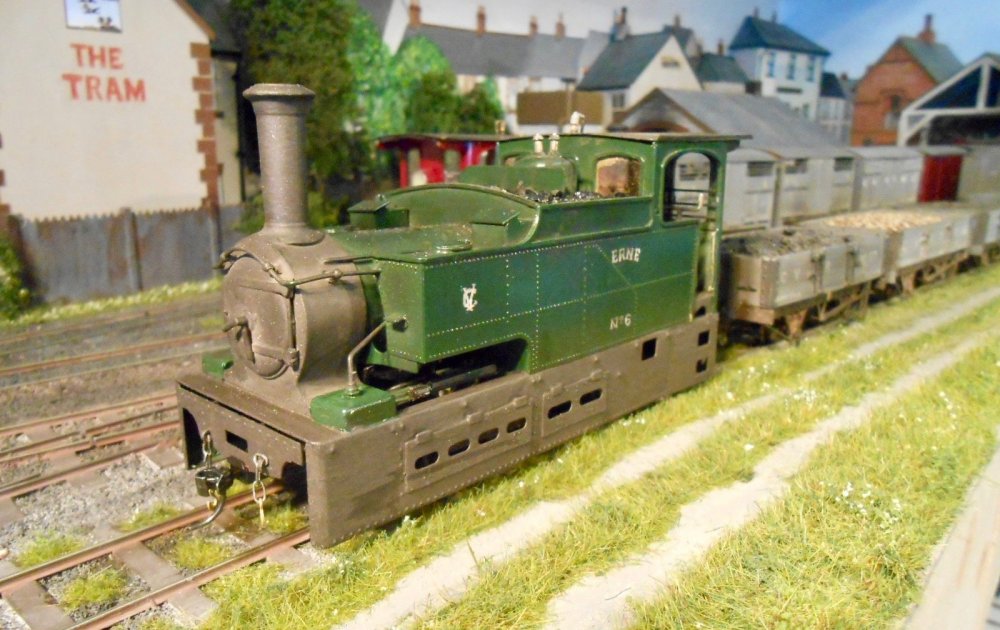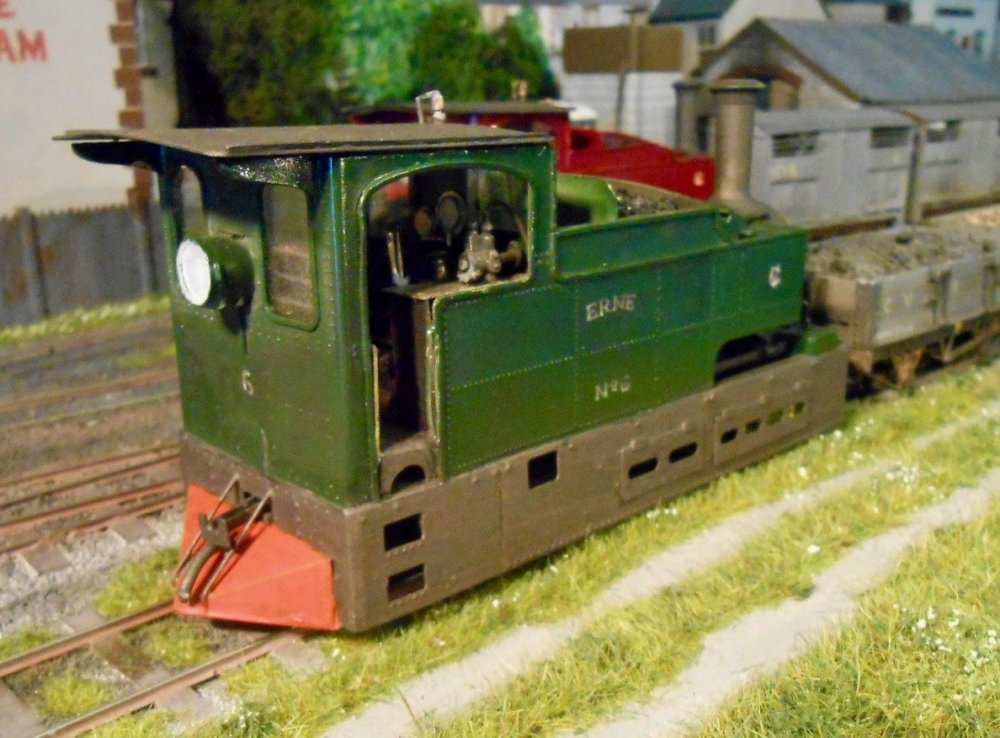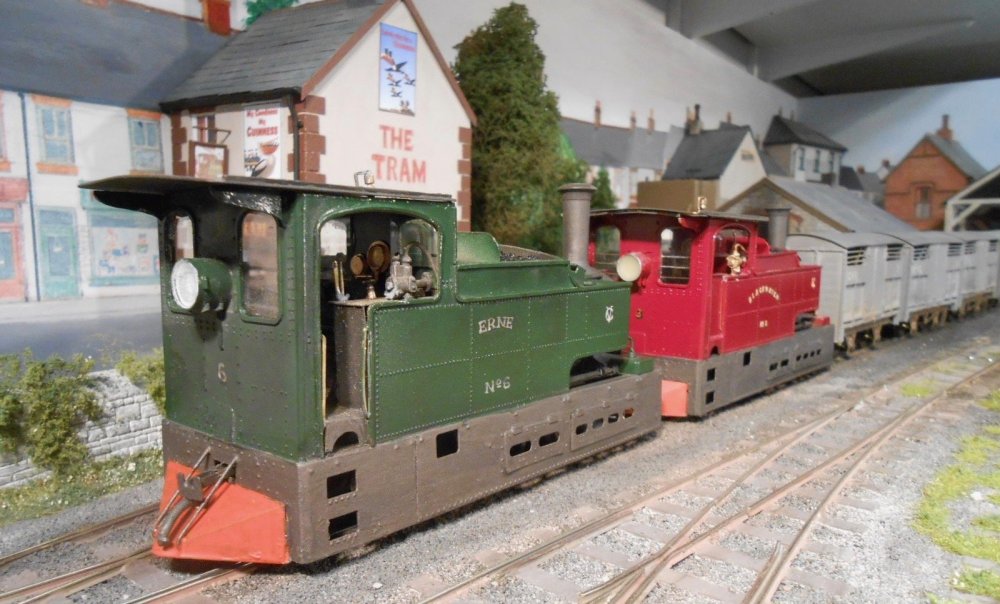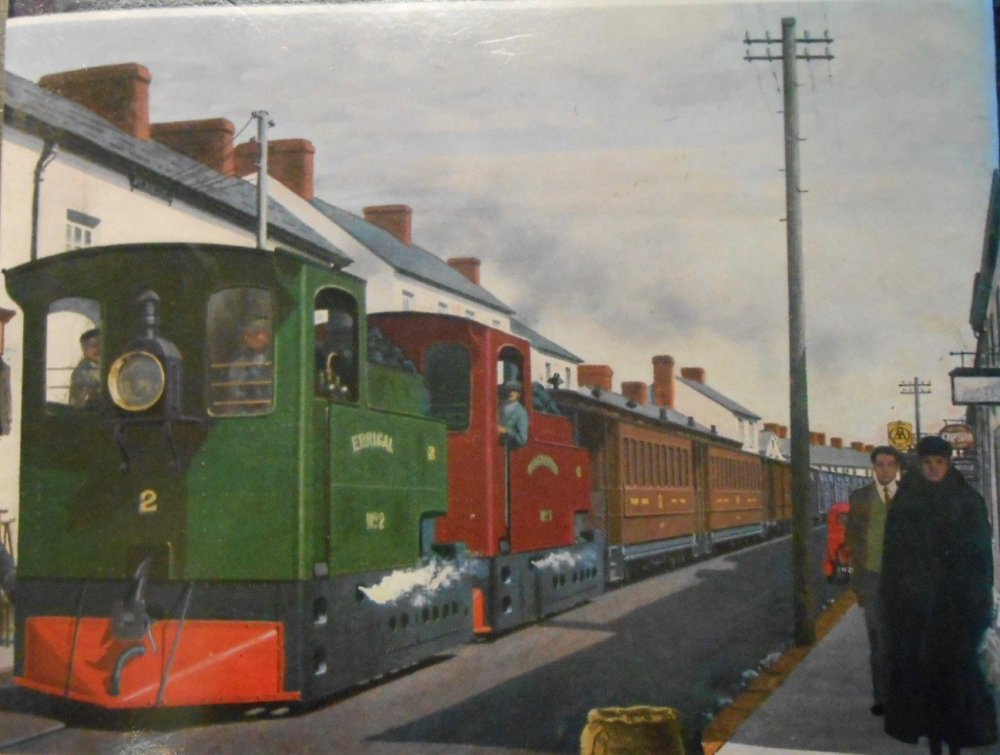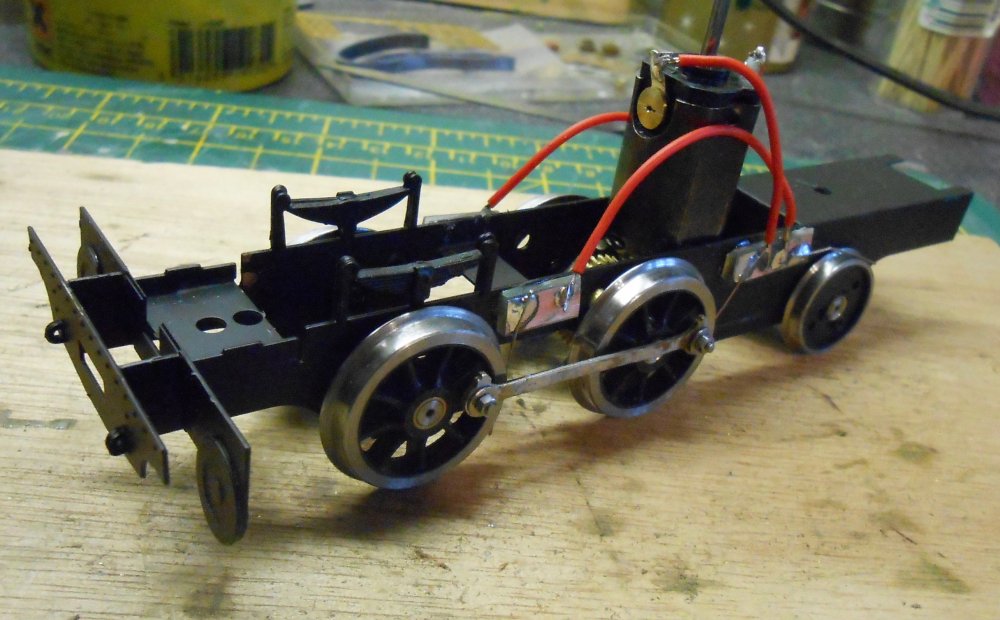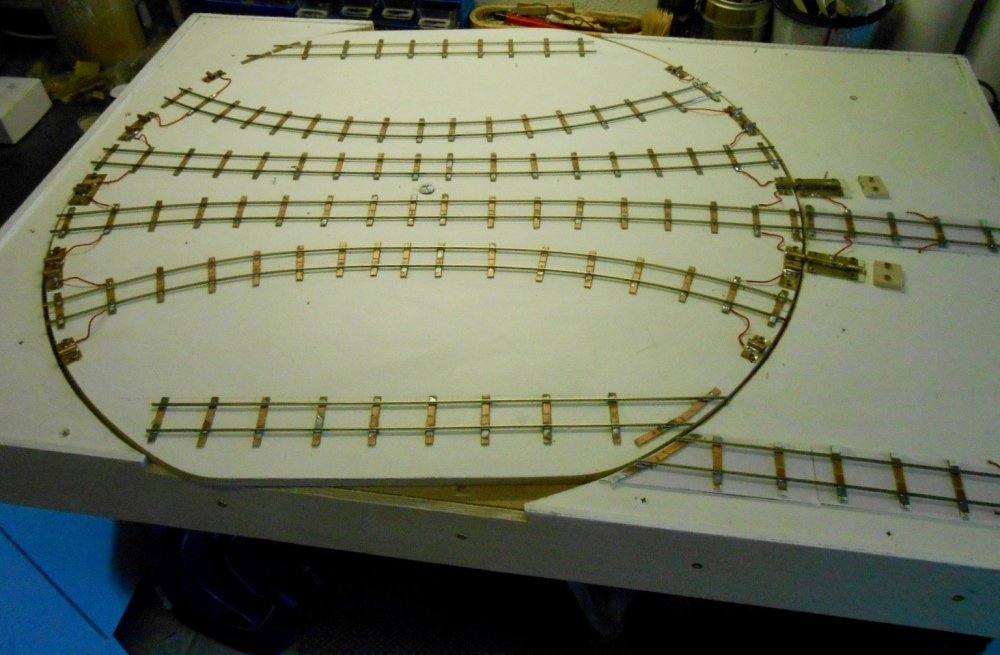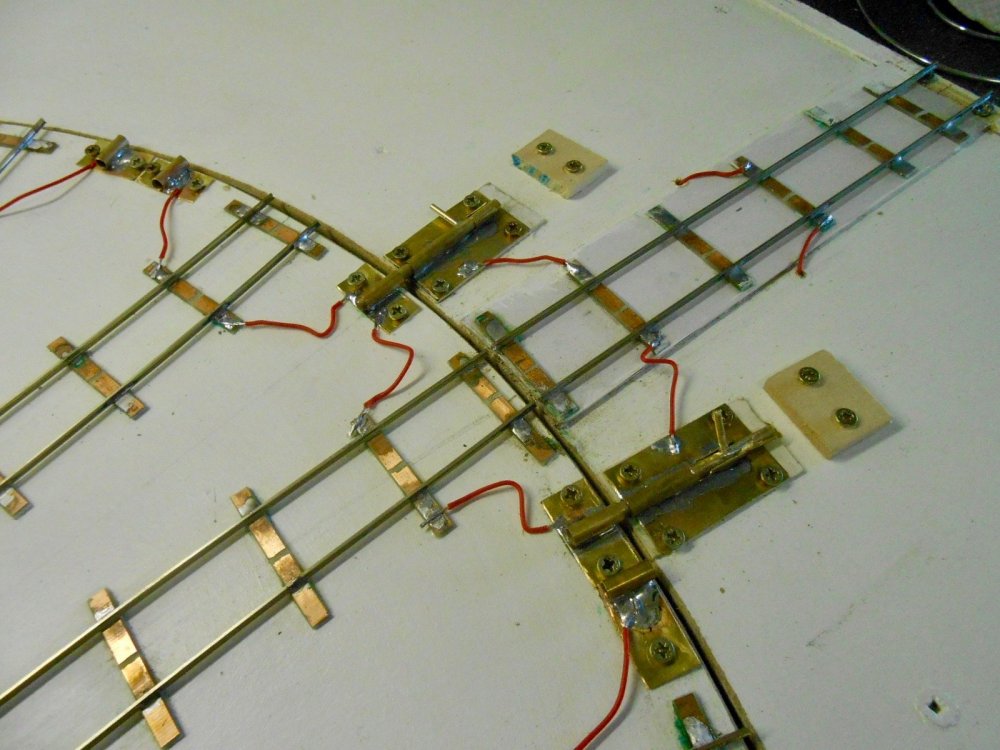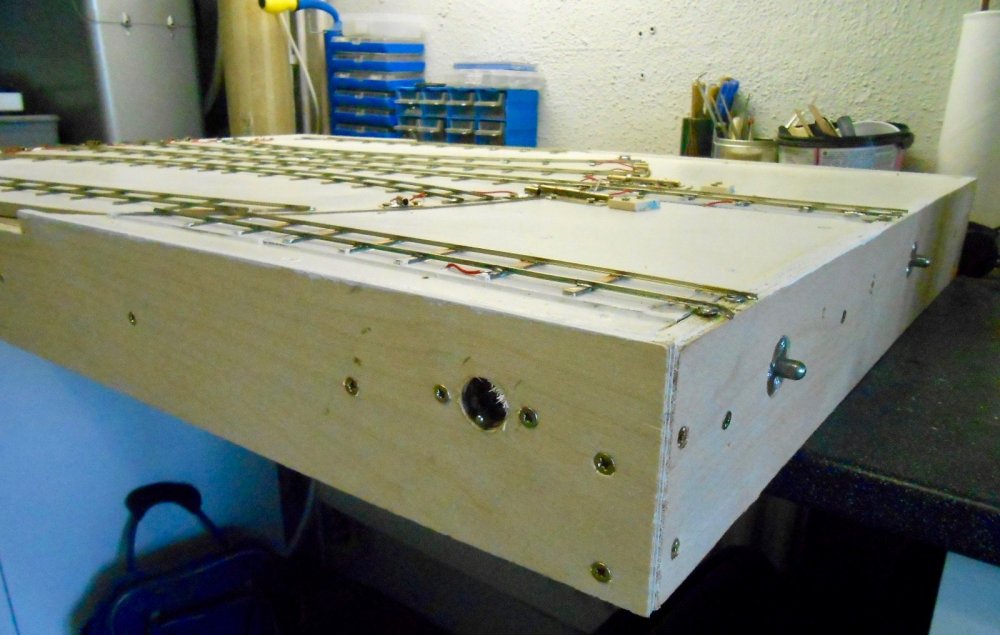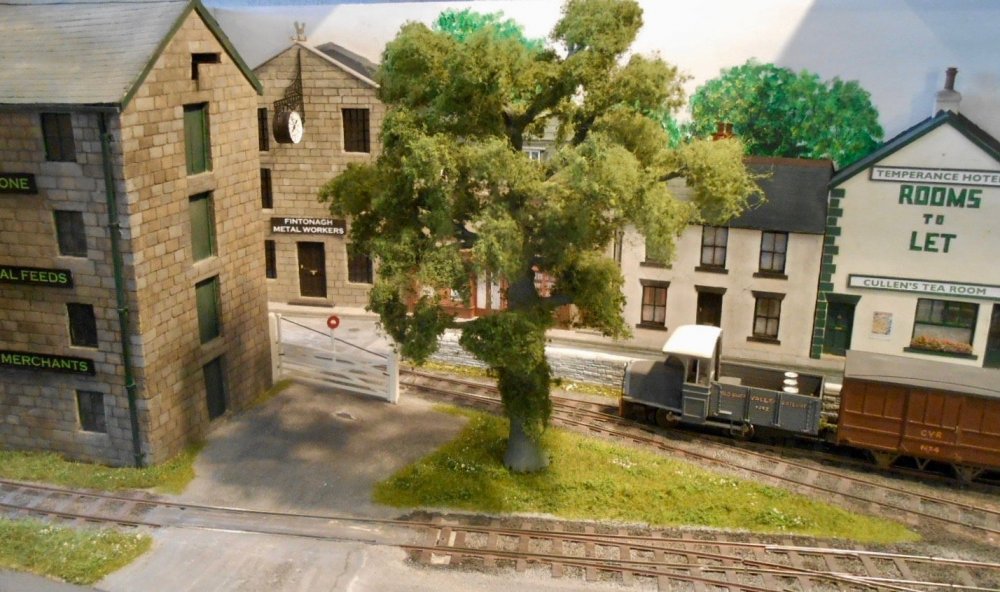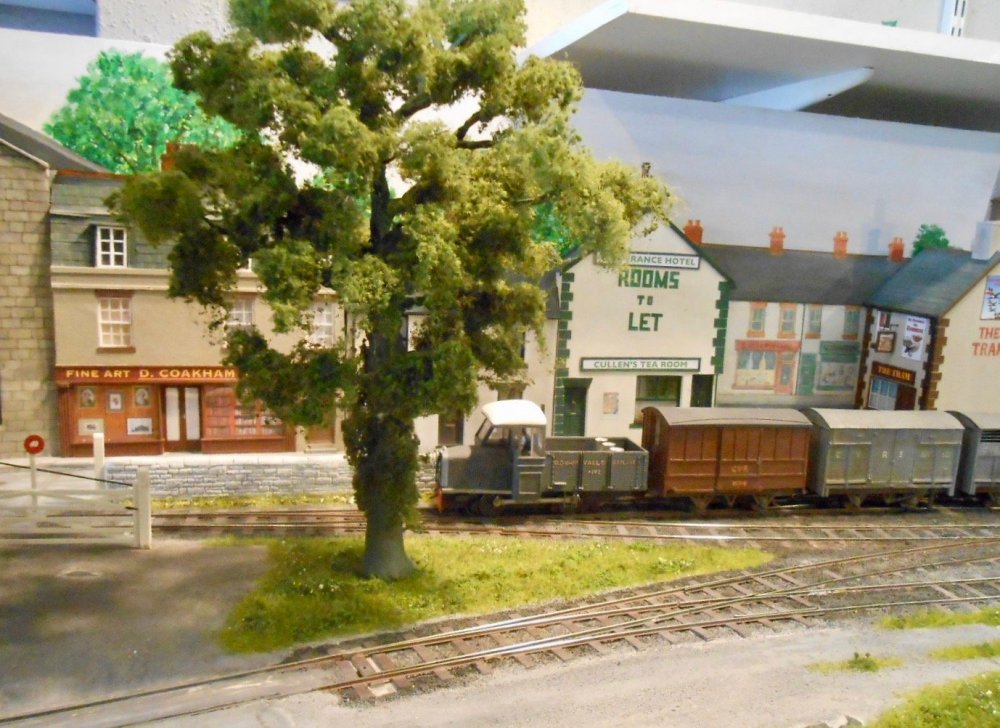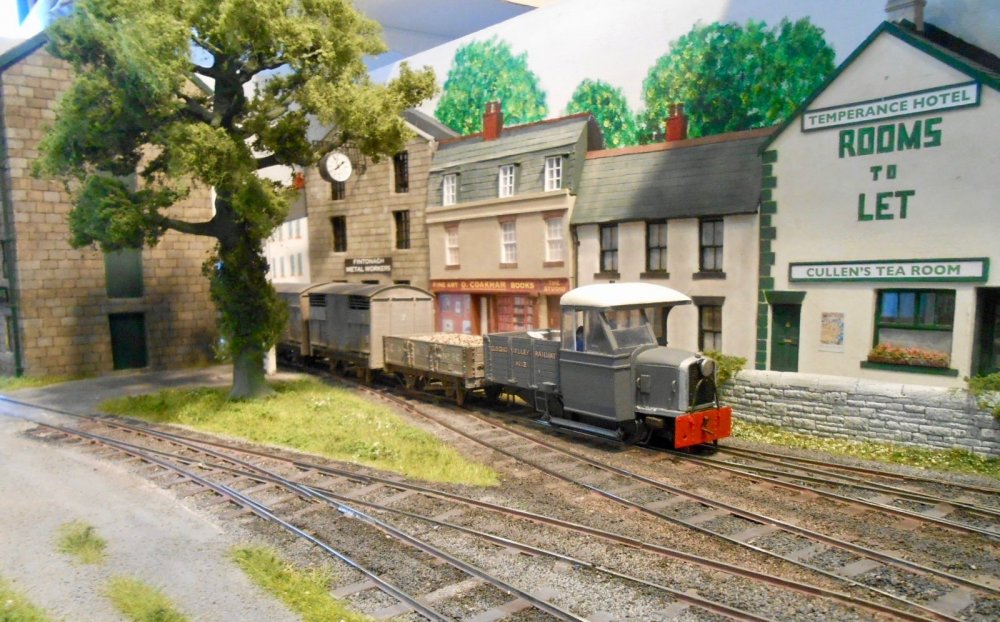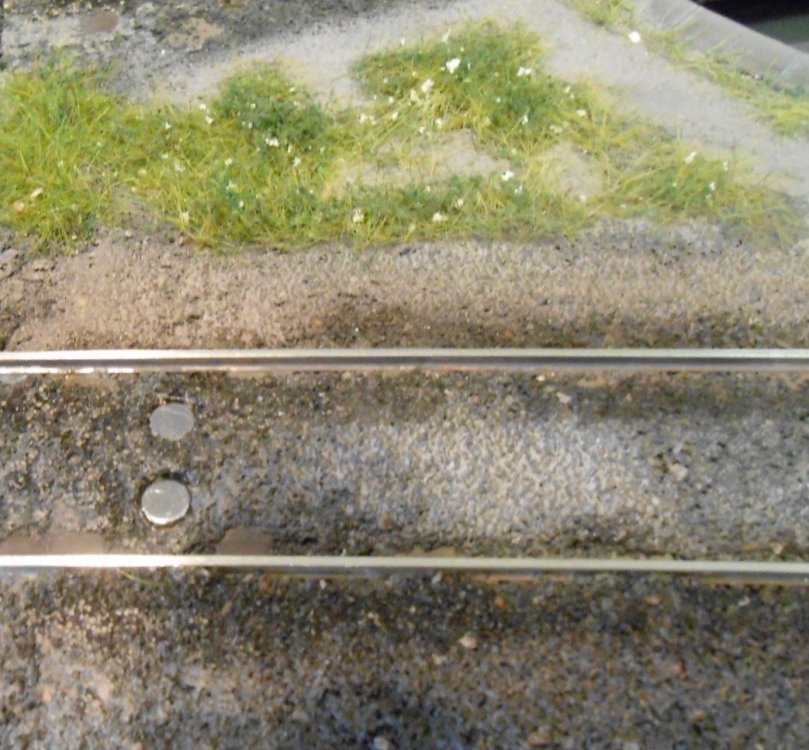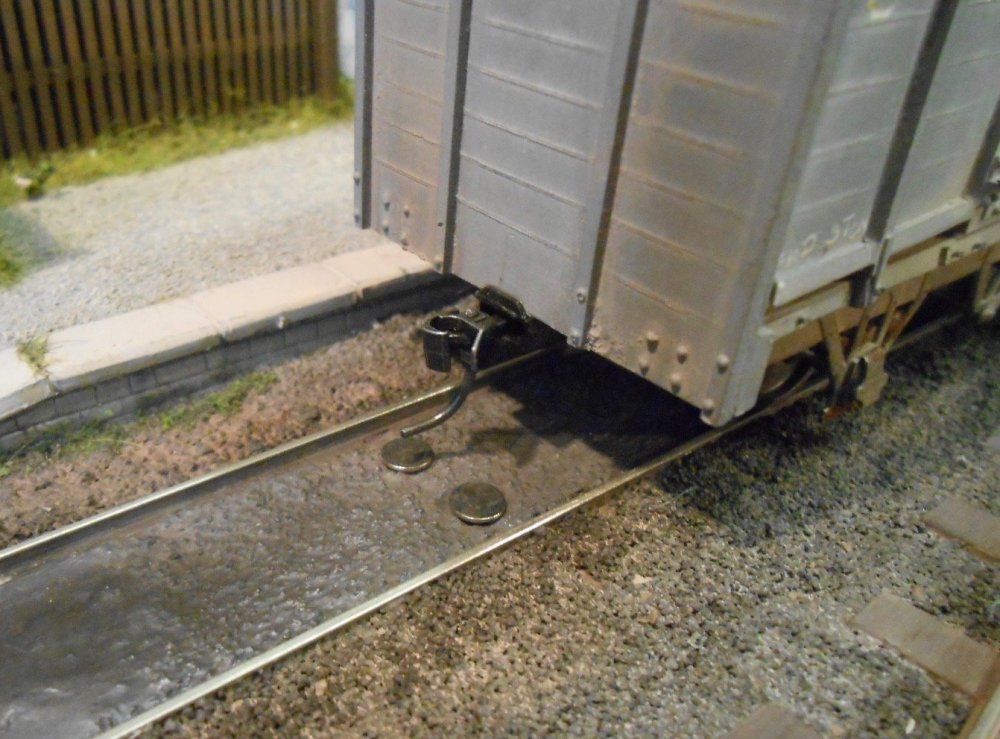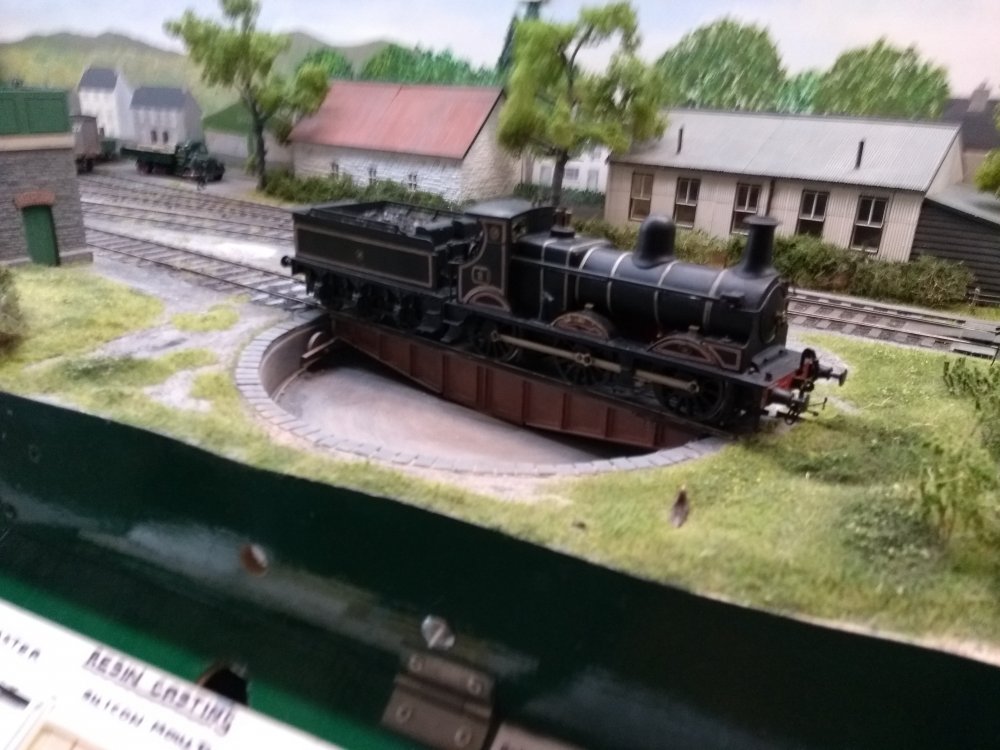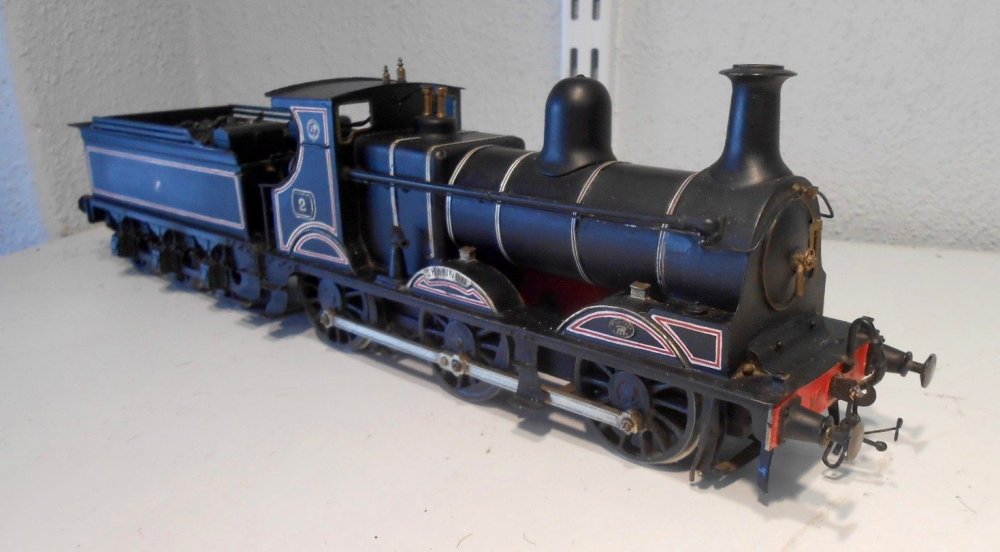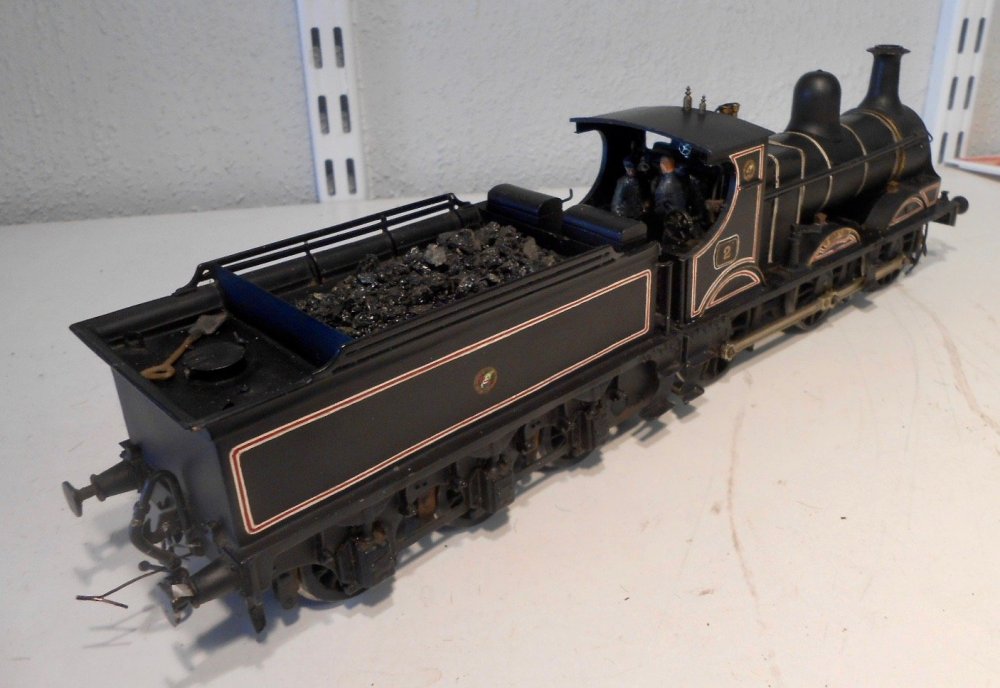
David Holman
Members-
Posts
4,352 -
Joined
-
Last visited
-
Days Won
117
Content Type
Profiles
Forums
Events
Gallery
Blogs
Store
Community Map
Everything posted by David Holman
-
Or Darleks! Not seeing the wheels is a bit of a negative, but their overall charm makes up for it, I think.
-
Eric and Erne Second Sharp, Stewart 0-4-2T Erne has now joined Eric [aka Blackwater] in the fleet. However, as neither of them have any crew yet, their cab roofs are not fixed. What I can now do is [sort of] recreate the Vic Welch painting on the cover of the original book by Dr Patterson. Erne was spray painted in Ford Laurel Green [using a Halford's spray can] and hand lettered with a fine nibbed dipping pen - initially in white acrylic ink & then gone over with a dark yellow fine marker pen. After, a small amount of shading was put in with a 0.3mm black drawing pen. This method has also enabled me to do the overlapping 'CV' logo on both tanks' sides.
- 266 replies
-
- 12
-

-

-
Super NG stock and models, plus I guess the 0 gauge is (slightly) narrow too, but then I would say that! Lovely stuff, either way. Would I be right in thinking the SLNCR 'small tank' is the same a certain Mr Sullivan of this parish, brought to Cultra when Arigna Town was there two years ago? Or, is it the fifth such model I've now seen (my two, Richard Chown's, Des's, plus one more)? Or indeed 6th, as there are two of them. Nice 0-6-0 and 4-4-0 too. Where are they now I wonder?
-
You're never alone with a clone... Hay fever season in these parts, so despite the nice weather, it is easier for me to lurk in the workshop. Back at Expo Narrow Gauge at the end of October, I bought a second Clogher Valley Sharp Stewart 0-4-2T kit from Ragstone Models. Unusually for me, it has been malingering on a shelf for the last eight months, so it seemed time to get it built, especially as I'd bought the additional bits and pieces from the Branchlines stand at the Chatham exhibition three weeks ago. There is not much point in re-iterating how I built it, for the kit is pretty painless and goes together really well. The etches are very accurate [little filler needed], with good quality castings and sensible instructions. It has got this far in just a week. Hence a clone of Blackwater, the first model. This one will be 'Erne' and as per the colour plate on Dr Patterson's book, is going to be green. As can be seen, it has already been given a witness coat of primer. The chassis rolled beautifully first time the rods were added and, unlike last time, I am not going to faff around with trying to make Joy valve gear as the motion is all hidden under the skirts. The only differences to Blackwater lie under the surface, as I somehow ended up with a 30:1 gearbox, instead of 40:1. Hence Blackwater will not be challenging it to a race.
-
And Hatton's are bringing one out soon for a mere £750... Am sure there will be plenty of takers, but Eoin's model shows that the journey can be so much more than the destination! As for livery, it is his customer's choice of course, bit for me, growing up by the East Coast mainline, it would have to be Brunswick green. All it needs now will be a rake of ten Gresley coaches...
-
One of these on my list as a 7mm scale model, so lovely to see it done so well in 4mm. Not tried citrus flux before, but certainly looks decent stuff. My Powerflux works a treat, but requires regular cleaning as I go along or everything will be green next day! Stainless steel sink cleaner does the job though.
-
Am just starting on researching a future project and am interested in the following, please: Woodwork colours on WLW, MGW and GSR buildings WLW carriage livery in 1900 MGW carriage livery in 1900 GSR carriage livery in the 1930s Have Ernie Shepherd's books on the WLW and MGW, which say crimson lake for the former and brown the latter, but anything more detailed would be appreciated and as for GSR, what best describes 'purple lake'? Realise these things are subjective and rather lost in the mists of time, but any help appreciated.
-
There is a school of thought that says in smaller scales, well printed papers work just as well as scribed or embossed finishes, especially from normal viewing distances of 60-90cms. What does stand out with Metcalf's parts is the corner joint. Easily covered with individually cut pieces of card and folded round the corners.
-
A stunningly ugly building, beautifully done!
-
It would be good if they did, but MRJ is notoriously fickle. For a long time, they never went outside Britain, then Pempoul came along and broke the mould, as it were. Since then, there have been a couple of Irish layouts, so who knows? With guest editors these days, depends on Barrow Road catching their attention. I sent an article on Arigna Town once, by post (they don't do email), and included a CD with text and photos. One of the latter made it into the magazine, but otherwise I never received any acknowledgement. By and large, they stick with what (and who) they know, which is not being derogatory, it is just how it is. I have got every issue, including zero, and still enjoy each new copy, even though the content isn't always what I am interested in. It's all about pushing the boundaries and getting back to Barrow Road, that is certainly a criteria you can apply. Let's hope it gets the attention it deserves.
-
Seems like it has been a long time since I posted anything on Fintonagh, but actually only a couple of weeks. However, that time did involve organising the club exhibition, so no wonder it seemed ages. In spare moments, have been working on the fiddle yard. The baseboard had been built at the start, along with the other two, so it has been about track laying, bolts and wiring. Usual flat bottomed code 83 rail, soldered to copper clad sleepers, though the latter more spaced out as it is not a scenic area. Unlike Arigna Town, this is just a turntable [not sliding/rotating], so have had to be careful with the geometry & the two outer tracks are quite tightly curved [about 60cm in places]. Home made bolts, using brass rod, tube and plate cater with alignment & these are just screwed into the MDF turntable. The latter sits on a large steel washer to help make rotation smoother. Electrical connection is also via the bolts, as can be seen from the short wires on the surface. The only other bit of electrickery is a simple SPST switch to isolate the from siding, which just about sums up my wiring ability... First indications are that stock runs ok, but fancy a bit of fine tuning will be needed, once I get the whole layout set up.
-
Rapidly developing into one of the finest modern image layouts of recent years. Atmosphere like this does not just happen, it needs masses of observation and artist skill to reach such a level.
-
Arigna Town gets another outing at my own Club's show next weekend, with Shannon putting in an appearance too. While Arigna is the only Irish layout this year, there is plenty of other good stuff, including Gordon Gravett 'Shannon' new layout 'Arun Quay', plus Melton Mowbray North in N gauge and Haverhill South in 2mm timescale. With American, Continental, narrow gauge, plus Z, 3mm, 4mm and 7mm scales all represented, there should be something for everyone. Extensive trade support too. If you are in Kent next weekend, come and visit. £6 for adults, with accompanied children under 16 free. Ample parking, easy access and quality catering at Victory Academy, Magpie Hall Road, Chatham.
- 1 reply
-
- 1
-

-
Arigna Town gets another outing at my own Club's show next weekend, with Shannon putting in an appearance too. While Arigna is the only Irish layout this year, there is plenty of other good stuff, including Gordon Gravett 'Shannon' new layout 'Arun Quay', plus Melton Mowbray North in N gauge and Haverhill South in 2mm timescale. With American, Continental, narrow gauge, plus Z, 3mm, 4mm and 7mm scales all represented, there should be something for everyone. Extensive trade support too. If you are in Kent next weekend, come and visit. £6 for adults, with accompanied children under 16 free. Ample parking, easy access and quality catering at Victory Academy, Magpie Hall Road, Chatham.
-
Kit building v RTR - Sometimes a false economy?
David Holman replied to Noel's topic in General Chat
DIY has always been an integral part of modelling less popular subjects, though these days, obscure prototypes, light railways and the like are increasingly well served by RTR. In some ways, this is a shame, because it is arguable there is now too much RTR and ready to plant structures, which may ultimately de-skill the hobby, if all you need to do is open a box and plonk a building on the layout. However, for those more interested in operation, clearly there is nothing wrong with that, which is why our hobby is so good for all sorts of interests. -
There is a school of thought that even in 7mm scale, any surface relief for brickwork is actually negligible, so printed card is all anyone needs. In 4mm, that would be even more appropriate. However, it is also arguable that emphasising certain aspects, such as brick and stonework helps create a better impression. The middle paths are either scribed Das clay (tedious, but very effective in 7mm), or something like the Howard Scenics embossed brickwork that Freestone Models sells. Can be coloured fairly easily with pastels or water colour crayons. Being a thick paper, you can easily get the mortar lines round corners too.
-
Always good to get a few mock ups in place to help visualise the scene.
-
..end of an era, by Conrad Natzio. Another fine Colourpoint book, published last year. Bought mine at the Derby show and very good it is too. Most of all an excellent reference on colours, not just rolling stock, but infrastructure, buildings and scenery, plus useful info in the extended captions. Not sure if it has been mentioned before and if so apologies. Otherwise can only say highly recommend.
-
- 1
-

-
Just did a Google search, Noel.Magnets4U, I think, who do a next day delivery. A pack of ten was less than a fiver.
-
Things arboreal Managed to buy some Woodlands scenic matting at the Derby show, so spent this afternoon 'dressing' the tree. Took a packet and a half - around a square metre in total. A [fairly] simple case of tearing off a few square cms, then teasing the piece out nice and thin, before glueing to the tree frame with PVA. Start at the bottom and work up, of course... The model is based on an elm, using Gordon Gravett's book, with little else extra needing to be said. The tree marks the end of all the structures on the layout now, with just things like nettles, weeds and some figures/vehicles to add. The other pictures are of the rare earth [neodynimium] magnets I am using with the Kadee couplers. Mine are 5mm diameter and 10mm long. Drilled two holes in the track, either side of centre line & the magnets are then a push fit. Seem to work ok, though will have to work on a few ideas to mark where they are, as the layout is front operated from either end.
-
That looks a nice job. Proper track gauge too - every little helps!
-
Splendid - and love the signs!
-
Arigna Town - this week's scenery
David Holman replied to David Holman's topic in Irish Model Layouts
Often tease kids that it is nice squeaking in the treadmill under the baseboard... -
Arigna Town - this week's scenery
David Holman replied to David Holman's topic in Irish Model Layouts
Great to meet so many people at Derby, including the group of Ulster modellers over for the weekend. Took Shannon with me and she ran well throughout. -
Shannon revitalised As the initial photos showed, Shannon was one very dirty engine when I took possession, but it was soon apparent that there was a very nice model underneath. A good dusting using a paintbrush was the first step, then I tried damp cotton buds to shift some of the grime. However, this only succeeded in moving the muck around, so out came the T-Cut. An automotive product for restoring paint, it works as a very gentle abrasive. Wipe on with a cotton bud, leave a short while and then polish off with a cloth or another cotton bud. I started with an area on the tender that would be covered with colour if the worst happened, but whatever paint Shannon was originally covered with was not affected - just the dirt came away. And it didn't actually take very long: within a couple of hours Shannon was looking a whole lot better. Left overnight, I then had a second look next morning to redo a couple areas and also polish off bits I'd missed earlier. However, polishing the T-Cut showed that the boiler bands were loose in places, so these were re-fixed using satin varnish. The other most noticeable thing wrong was all the chipped paint, with two areas on the cab roof and another on the boiler needing serious attention. It is one thing to touch up a bit of bare metal, but the covering needs to come level with the rest of the paint, or it still looks wrong. Then there is the problem of 'black'. Whatever shade Shannon was originally painted, it is neither matt, nor really satin black, more a very dark grey, with a tiny touch of blue. First I gave the bare metal a wipe with 'Birchwood Casey Gun Blue' - which is as per its name. Comes in a plastic bottle from Eileen's Emporium if [like me] you don't have a local gunsmith handy. Essentially selenium dioxide, thirty seconds is enough to blacken most metals, then you neutralise it with tap water: cotton buds again. After went over all the bare areas with a black spirit pen/marker, then it was time to get out the acrylics. An exact colour match wasn't important initially, more a case of building up layers to bring the bare areas level with the rest of the paintwork, while using acrylics meant there was only a few minutes drying time needed between coats. Eventually got the levels about right, then smoothed everything off with some 1200 grit wet and dry before finally trying to blend the paint in with the old top coat. The latter was slightly satin though, but rather than use varnish, I got the T-Cut out again and used this blend & polish the two areas together and [fingers crossed] it seems to have worked quite well. There were still a few other areas to attend to. The old coal load in the tender was scrapped in favour of a larger piece of plastic sheet [black this time], covered with real crushed coal glued in place the same way as ballasting track. Exposed brasswork, including name and number plates got a gentle polish with the 1200 wet & dry, while the crew got a fresh coat of acrylic [same colours as before] & were then glued back on the footplate. The last job for now was making a better join between the boiler and smokebox. The frames, footplate and smokebox are all one unit, with the boiler and cab the other. The only fixing is a 12BA screw in the cab floor, with the boiler being a push fit in the smokebox. However, there is only 1mm overlap here, so I introduced a brass peg - 1.2mm wire, soldered into the end of the boiler, which engages in an existing hole in the back of the smoke box. This stops the boiler moving when you pick the engine up and [hopefully] reduces the strain on that tiny screw. Shannon is quite heavy - the boiler has a copper bar inside for weight, while the tender has the PFM sound system. All this is moved along by a very small Escap motor, but, it seems to work fine. What I haven't done yet is have a go at the wobbly centre driver. Being flangeless, it doesn't seem to affect running, but when the Gravetts visit in a few week's time, I'll see what Gordon thinks might be done. So, there you are, a fine model, now looking smart again. It has been a pleasure to work with, not least because it has helped me appreciate how Shannon was built and discover some [though by no means all] of the fine details that have gone into her. Compare these new photos with the first ones from last week and hopefully, you will see quite a difference.
.png.c363cdf5c3fb7955cd92a55eb6dbbae0.png)
